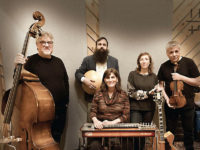Whether her instrumentation or expands and contracts, the reach of Mary Halvorson’s artistic flair keeps widening with each release. After dropping a brilliant solo guitar record onto the jazz world in 2015 (Meltframe), Halvorson returns to her ever-enlarging ensemble, which was once formed by her, Ches Smith on drums and John Hébert on bass. Over time, she augmented the trio with a quartet of horn players (Jon Irabagon, alto sax; Ingrid Laubrock, tenor sax; Jonathan Finlayson, trumpet; Jacob Garchik, trombone). That was the septet that convened for Halvorson’s last band record, Illusionary Sea (2016).
So in keeping with the pattern of expansion, Halvorson unveils an octet for Away With You (now out from Firehouse 12 Records), but also in keeping with her audacious unpredictability, that eighth seat is occupied by a pedal steel player. Susan Alcorn started out in country-western pedal steel but eventually developed her own technique informed by free jazz, avant-garde classical music, Indian ragas, and various folk music from around the world. It’s not hard to imagine the potential that Halvorson saw after seeing Alcorn perform live on multiple occasions.
The eight new compositions on Away With You were written by her with Alcorn in mind, but smartly integrates Alcorn as part of a group that includes all those horns and another chordal instrument, not as some curiosity to the jazz world. Conversely, Alcorn’s pedal steel is implemented in ways that are foreign to accustomed way such an instrument is played but makes sense within the context of Halvorson’s world.
For example, “Fog Bank (no. 56)” presents the lonely, strangely dissonant sound of Alcorn’s pedal steel guitar, played in a way rarely heard but fits the ghostly somber sentiment of this song. Alcorn’s slow procession of notes spelling out the main harmonic thread of “Inky Ribbons (no. 53)” is in essence assuming Halvorson’s usual role. Halvorson essentially engages in a duet with Alcorn for the first half “The Absolute Almost (no. 52),” the bending notes of the pedal steel a perfect companion to the signature bending note style of Halvorson. The heralding horns brings the rest of the band in, and what follows is a carnival ride through advanced harmonics.
The leader has hardly forgotten about the rest of the band, though, and she knows just how to deploy each piece individually and together in service of her songs, demonstrated so well on “Away With You (No. 55).” The punchy horn lines and whistle-able melody deceives you into thinking it’s some lost 70s television theme song at first as the climbing and falling sequence of note forms the foundation for a tune that these horns dance around. Increasingly, it becomes avant-garde that rocks (complete with faint echoes of the Blue Oyster Cult’s “Don’t Fear The Reaper”). When Halvorson takes a solo, Hébert and Smith syncopate like they are inside her head. When Finlayson takes over, the rhythms section gets shifty, competing with the trumpeter for attention an example of Halvorson’s sophisticated and imaginative arrangements.
“Spirit Splitter (No. 54)” likewise starts off in a deceptively high school recital fashion, but the complexity slyly reveals itself over time, and culminates into a free/psych breakdown that sounds like nothing else save for perhaps Sun Ra’s Arkestra.
For “Sword Barrel (no. 58)” Halvorson shows off her use of microtones, but Irabagon takes most of the spotlight with a frisky solo before the band races up to a high note. “Old King Misfit (no. 57)” begins with an unusually played Hébert bass soliloquy, with a lot of strumming and high/low contrasts. It sets up the succession of repeating notes right on the beat while the horns cavort around it. “Safety Orange (no. 59)” pits the pure trumpet tone of Finlayson against the bright, chiming guitar of Halvorson.
Mary Halvorson occupies her very own space, making the only sensible comparisons of her work is with her other works. Inspired by Susan Alcorn’s pedal steel guitar, Away With You keeps Halvorson’s idiosyncratic ideas fresh and pushes forward her boundless conception of jazz on the frontier.
- Christian Marien Quartett – ‘How Long Is Now’ (2024) - April 18, 2024
- Dave Douglas, feat. James Brandon Lewis – ‘Gifts’ (2024) - April 11, 2024
- Thollem – ‘Worlds In A Life, Two’ (2024) - April 8, 2024



